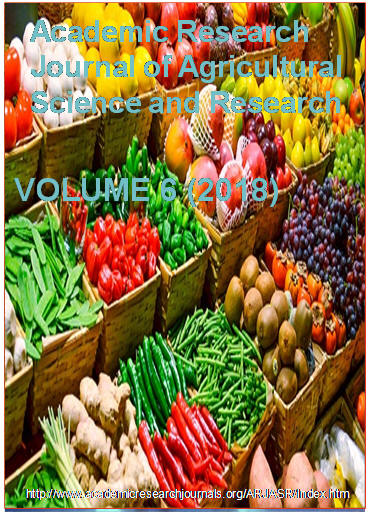| ARJASR |
Academic Research Journal of
Agricultural Science and Research |
||||||||||||||||||||||
|
Academic Research Journal of Agricultural Science and Research Vol. 6(3), pp. 172-192. April, 2018. ISSN: 2360-7874 DOI: 10.14662/ARJASRD2018.026 Full Length Research Yield and Yield Components of Onion (Allium cepa var. cepa) Cultivars as Influenced by Population Density at Bir Sheleko, North-Western Ethiopia
Tegbew Walle 1*, Nigussie Dechassa2, Kebede W/Tsadik 3
1*Department of Horticulture, College of Agriculture and Natural Resources , Debre Markos University, P.O.Box 269, Debre Markos, Ethiopia 2 School of Plant Science, Haramaya University, Dire Dawa, Ethiopia 3 School of Plant Science, Haramaya University, Dire Dawa, Ethiopia *Corresponding author: walleyesigat@gmail.com
Accepted 27 April 2018
Onions are among the most important vegetable crops produced in Ethiopia by both smallholder farmers and commercial growers for both local and export markets. However, information on plant population density that may provide optimum yield of bulbs for different cultivars is scanty. As a result, growers often use unspecified plant population densities for different cultivar, which could lead to sub-optimal bulb yields. Therefore, field experiment was conducted with the objective of determining the influence of plant population density on yield and yield components of two onion cultivars. The experiment was laid out as a randomized complete block design in a factorial arrangement in three replications. The treatments consisted of six plant population densities of 25, 33.33, 50, 66.67, 100 and 200 plants m-2 obtained from spacing of 40 cm x 10 cm, 30 cm x 10 cm, 20 cm x 10 cm, 30 cm x 5 cm, 20 cm x 5cm, and 10 cm x 5 cm, respectively and two popular onion cultivars (Adama Red and Bombay Red) in the study area. The data revealed significant differences in plant height and leaf length at maturity, bolting percentage, shoot fresh and dry weights, weight of marketable and total bulb yields, biological fresh and dry matter yields, average bulb fresh and dry weights, and neck diameter due to the main effects of cultivar and population density. Cultivars had significant main effects on harvest index, days to maturity, and biomass yield. Bombay Red was found to be superior to Adama Red in most parameters measured. Similarly, the main effects of plant population density had significant influences on the number of leaves per plant, number of marketable bulbs, and percent dry matter. The highest plant population density (200 plants m-2) resulted in the highest weights of marketable bulbs (47540 kg ha-1), total bulb yield (51137.2 kg ha-1), and the lowest bulb fresh weight (45.89 g). The interaction effects of cultivar and population density resulted in significant variation only in bolting percentage. However, plant height, leaf number per plant and leaf length at 30 days after transplanting, and total soluble solid content of onion bulbs were influenced by neither the main effects nor the interaction effects of cultivar and population density. In general, it could be deduced that plating onion at highest population density (200 plants m-2) could out-yield those of lower densities. However, optimum bulb size for fresh market use is generally contradictory whereas market in the study area accepts a bulb size of 20 g as marketable; the national recommendation for onion bulb size is 60 g. Thus, compromise decisions must be made for wider market and, hence, it could be recommended that preferred onion bulb size could be achieved by adopting 66.67 plants m-2 population density. Moreover, additional research on the cultivars for more seasons and under different agro-ecological conditions is suggested to draw a conclusive recommendation.
Keywords: Onion, Cultivars, Plant population, yield components, yield
How to cite this article: Walle T, Dechassa N, Kebede W/T (2018). Yield And Yield Components of Onion (Allium cepa var. cepa) Cultivars as Influenced by Population Density at Bir Sheleko, North-Western Ethiopia. Acad. Res. J. Agri. Sci. Res. 6(3): 172-192
|
|
|||||||||||||||||||||
